15 German Shepherd Colors
March 1, 2021 2021-10-04 9:08Did you think German Shepherd Dogs only came in black and tan? Thanks to the famous Rin Tin Tin, “black and tan German Shepherds are most common, especially in the United States,” but there are 14 other eye-catching colors, most of which are registered.
Most color varieties have some black face masks and some kind of black body marking, ranging from “a classic ‘saddle’ to an overall ‘blanket.'”
Some German Shepherds sport rare color variations, including sable, black, white, liver, and blue. Although the “all-black and sable varieties are acceptable according to most standards…, the blue and liver are considered to be serious faults.”
Discover the full spectrum of German Shepherd Dog colors, from the six old colors to the five recognized color patterns, before choosing your favorite.
Table of Contents
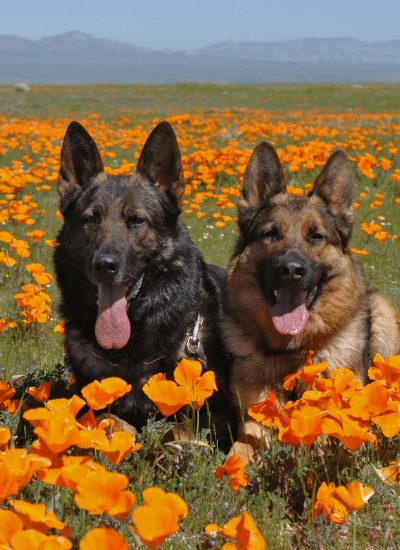
15 Colors of German Shepherd
Let’s look into this breed’s colorings – from very common to very rare!

Black and Tan
This is the color most of us think of when we picture a German Shepherd dog. With a rich tan undercarriage and a black face and back, this color of GSD has been around since the very first was officially registered back in Germany at the end of the 19th century.
Although Horand von Grafrath was a little darker than the modern black and tan GSD, the ancestry is evident.
The Black and Tan coat “is recessive to the most dominant sable gene, but it is dominant over the solid black recessive gene.”
Usually born darker, black and tan GSDs lighten as they age, with some even developing “a gray strip down their backs,” often known as a “bitch’s strip” as it is more common in female German Shepherds than males.
Pure Black
Some think the black German Shepherd is somehow different from the black and tan variety whereas others argue that the “color has no impact on their characters or temperaments.”
Breeders specializing in the production of pure black German Shepherds may claim that their “larger and more muscular” than other types of German Shepherd, but there is no clear evidence of this.
Some devoted owners claim that their black GSDs have coats that are “more luxurious and ‘flowing’” than other types but, again, there’s little evidence to support this claim either.
Given that some still believe that “To meet this black dog at night is a truly bad omen, and perhaps even a portent of death,” it’s hardly surprising so many false claims exist about the black German Shepherd.
Black German Shepherds are “accepted by all major cynology associations,” including The Kennel Club and the American Kennel Club (AKC).
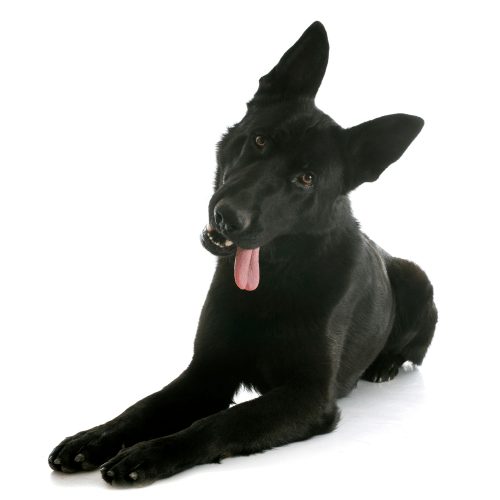
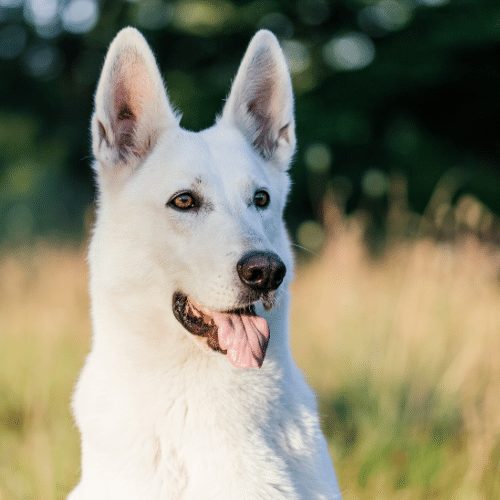
White
While many of us have seen white German Shepherd dogs, few of us probably realize what we’re looking at. With their luxurious white coats, these pale dogs look more like Golden Retrievers with erect ears.
Often confused with the even more unusual White Swiss Shepherd, or Berger Blanc Suisse, the white GSD is the cause of great controversy. (You also shouldn’t confuse this one with the white Husky, a type of Husky coloring who looks very similar! However, unlike a Husky the White German Shepherd will rarely have blue eyes)
According to the AKC, white dogs are always disqualified from dog shows.
The UK Kennel Club is similarly dismissive of the white German Shepherd, going as far to say that “light markings on chest or very pale color on the inside of legs permissible but undesirable” while “whites and near whites are highly undesirable.”
The United Kennel Club is one of the few that recognizes the white German Shepherd, pointing out that the “German Shepherd Dog comes in many colors and white.” Even the UK Kennel Club notes that “Colour in itself is of secondary importance having no effect on character or fitness for work.”
Despite this, “in 1959, Germany began culling White German Shepherds from the German Shepherd breeding lines because they saw these dogs as Albinos” and believed the white gene was responsible for “hereditary issues and washes out the breed’s rich colors.”
Liver
With its rich, reddish-brown coat, and amber-colored eyes, the German Shepherd dog is both distinctive and eye-catching.
The liver coloring is produced by a recessive gene and, for a German Shepherd puppy to “be born, its parents both need to possess at least one liver gene, which are passed to the puppy in its DNA material.”
Although the AKC says, “most colors are permissible” in its German Shepherd Dog breed standard and that “strong rich colors are preferred,” it also says that “washed-out colors and blues or livers are serious faults.”
Despite its confusing and seemingly contradictory statements, “a liver-colored GSD is recognized by the AKC,” but it “has to be a solid liver. Any other patterns such as black and liver or liver and tan aren’t acceptable as breed standards.”
Liver German Shepherds are among the rarest, so you’re unlikely to find one at a shelter or rescue center. Most liver GSDs are produced by “designer or specialty breeding programs,” but they do sometimes appear “randomly in litters of regular breeding programs.”

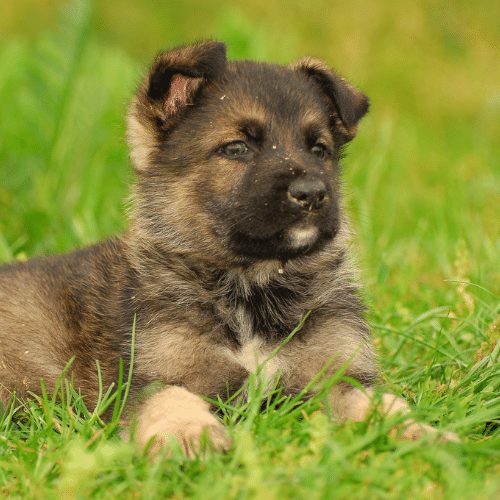
Blue
A blue German Shepherd is a rare but beautiful sight. There’s something almost magical about a blue dog, and with golden-brown or amber-colored eyes, they look even more exotic, making them highly sought after.
Despite their popularity, like the white German Shepherd, the blue has been a cause of controversion in the Shepherd world because recessive dilution gene comes with inbreeding practices and health issues.
While it’s true that both the unusual eye color and the blue or “cool steel grey” of their coats is due to a recessive dilution gene, there’s no indication that they are anymore “predisposed to any health problems” than the black and tan variety.
Blue German Shepherds may appear gray or even silver and are sometimes mistaken for a Blue Belgian Malinois.
Although some say “that blue is a bad color,” it doesn’t change the natural character of the dog, and a blue GSD will have the same “straightforward nature of a gentleman” that a black and tan one does.
Isabella
This unusual coat color variation is another washout as far the AKC is concerned, which is a shame given how striking it is. It originates from genetically combining liver and blue dilution genes.
Like the liver and blue German Shepherd dogs, Isabella GSDs often have unusual eye coloring and different colored noses. Liver German Shepherds will usually have a brown nose. Blue German Shepherds have a blue nose. The Isabella’s nose color will range from pink to liver or any shade in between.
As the liver gene blocks all black pigmentation, Isabella GSDs “won’t have any black pigment on their paw pads, noses, or eye rims” and will usually have either light-blue eyes or hazel ones.
There is no evidence that the Isabella coloration makes the dog more susceptible to health issues. However, Isabella is a recessive trait. Selecting for recessive traits always limits the gene pool and makes dogs more susceptible to genetic conditions.
Grey
Not to be confused with the silver, black, or blue German Shepherds, the gray variety look more wolf-like with their dark coats. This coloring is also called “wolf-grey”.
While some say “Gray German Shepherd dogs are a type of sable or Agouti, as it is also known,” gray is one of the six solid colors recognized in the AKC’s GSD breed standard although the genes responsible for the gray color can also “be found in the A series Agouti genes.”
Unlike the liver and blue GSDs, the gray color is produced by a dominant gene rather than a recessive one, making it easier to breed for. Puppies only need one dominant gene from either parent to produce a specific color, “but in order to express a recessive color gene, the German Shepherd puppy will need to inherit two copies of that color gene – one from each parent dog.”
Many gray German Shepherds also lack any black pigmentation, differentiating them from the sable which usually has black tips to their hairs.
Gray German Shepherds aren’t as rare as, say the Isabella or blue, but they’re still uncommon so, you’ll be lucky to find one available for adoption. Some breeders specialize in producing dogs of this unusual color.
Silver
Similar to the gray German Shepherd, silver is nevertheless recognized as a distinct color. Often grouped together, however, the gray and silver colors are produced by the same genes.
Finding a breeder that specializes in silver German Shepherds is a lot easier than finding one that focuses on the grey, so this might be your best bet if you want a more exotic-looking companion.
Silver is an uncommon color for GSDs, possibly because it is a recessive gene. Similar to the dilution gene, this gene influences black pigment.
While you also get silver sable German Shepherds, the patterned coats mean they are categorized as sable rather than silver.
Although recognized by the AKC, silver GSDs aren’t common in the show ring, with preference being for more vibrant, strong colors. However, silver German Shepherds are often seen in military work or the police force.
Black and Red
Seeing as I grew up idolizing the Red Setter, the fact that I love the look of the black and red GSD shouldn’t come as a big surprise.
The rich red pigment replaces the tan of the standard German Shepherd’s coat while the pattern remains much the same, with many black and red GSDs having the same black mask and saddleback of the black and tan.
The red color is the result of the color gene pheomelanin. It can have any shade of red, ranging from strawberry blonde to a deep mahogany red.
Alongside black and tan, the black and red combination is preferred over others by German Shepherd breeders.
As black and red are both produced by dominant genes, this color combination is easier to breed for, and many breeders focus on producing purebred dogs with deep red coloring.
Sable
A classic color for the German Shepherd, a sable comes in a variety of colors but each hair sports a black tip. Sable GSDs can be black, gray, red, silver, or tan and are also known as agouti.
Agouti is a type of coloring also present in other dogs, like the Agouti Husky. In this coloring each hair has several bands of brown and black, leading to a typical wolf-like coloration. Some founding members of the German Shepherd breed believed this should be the only color present in German Shepherds.
The sable coloring changes throughout a puppy’s life. Black sables are born as all-black pups and tri-colored sables are born as black and tan puppies. As the puppy ages, their coloring changes. Some GSDs may take as long as three years to develop their final sable coloration.
As every sable GSD is different, with the color and pattern both varying, it makes for an eye-catching and unique dog.
Sable is a dominant color that is easy to breed for. If you breed a Sable German Shepherd to any other color, you will likely get sable puppies.
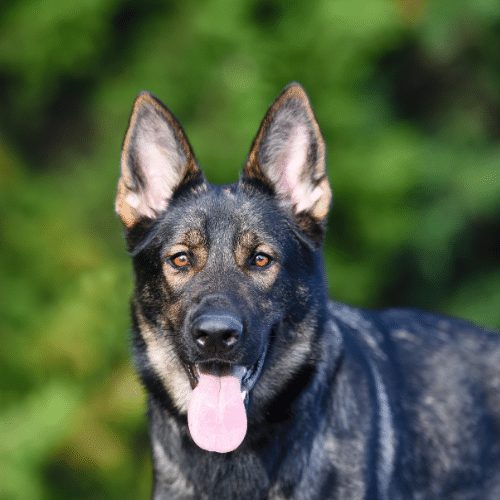
Black and Silver
Much like the black and tan GSD, a black and silver German Shepherd usually has a silver saddle across its back, although the pattern and hue both vary from dog to dog.
Like the silver GSD, the black and silver coloration occurs only when the recessive intensity suppression gene is present.
This color is not common in the AKC show ring and can mostly be found in working dog lines. Because these dogs are not visible in the dark, it is highly advisable to only walk them on a light-up dog collar in the evenings and at night.
Bicolor
Bicolor German Shepherds appear almost completely black and, to fit the breed standard, must have black heads, back, legs and tail. Even if their paws are brown, the heels need to be black by the color standard definition.
Some GDS enthusiasts have questioned if bicolor is actually a color or “just” a pattern of a different color. However, the AKC accepts bicolor as a recessive color in the breed.
Though technically allowed in the show ring, these dogs are mostly found in working lines.
Black and Cream
The last official color on our list, the black and cream GSD remains true to its origins as a lighter version of the common red and tan coloring.
There is some controversy surrounding the black and cream variation. Most AKC breeders do not want them to participate in the show ring. They strive to breed darker dogs that do not show the light cream coloring.
The color does little to change their character, however, and black and cream GSDs excel obedience, nosework, rally and agility and are as loyal and brave as their black and tan cousins.
Panda
A Panda German Shepherd looks similar to a Border Collie. The first Panda GDS was Lewcinka’s Franka von Phenom. Some claim she wasn’t a purebred German Shepherd but a GSD/Collie cross. Her DNA proved them wrong, although the Panda coloration remains unrecognized by some kennel clubs and breeders.
The Panda GDS is created by a rare genetic mutation. The so-called piebald gene causes up to 40% of the dog’s body to be white. However, the Panda GDS has no white German Shepherds in his ancestry. The genes responsible for an all-white body and the patchy white are two different ones.
The AKC does not recognize Panda German Shepherds as an accepted color. This does not stop them from being popular however! There is a large demand for Panda-colored German Shepherds.
Unfortunately, this inflates the price and leads breeders to focus on the color mutation rather than genetic health, so be sure to only source a puppy from a reputable breeder.
Albino
An albino German Shepherd is incredibly rare. While several people claim to own albino GSDs, on closer inspection, nearly all are White German Shepherds.
An albino of any species or breed lacks any pigmentation, including of the skin, hair, and eyes as well as the blood vessels, resulting in a pinkish tinge.
You can distinguish an albino German Shepherd from a white one by checking his eyes and nose. A White GDS will have some pigmentation resulting in brown eyes, whereas albinos always have red or pink eyes.
An Albino GSD, should one exist, may experience other health problems associated with the condition. They may, for example, be photosensitive, requiring protection from direct sunlight.
What is the Rarest Color of the German Shepherd?
The rarest color of German Shepherd is the isabella due to the recessive combination of liver and blue.
You will have to search for a long time to get such a puppy – and his price will likely be high as well!
What is the Best Color for a German Shepherd?
The best color for a German Shepherd in the show ring is black and tan, followed by sable.
If you are not planning on showing your dog through the AKC, you can pick any color you like. As the breed founder, Captain von Stephanitz said, “the coloring of a dog has no significance whatsoever for service.”
In working circles, many owners dislike the white German Shepherds – they are thought to be “weak”. This is not based on any actual working abilities though and more of a myth that has been passed on through generations.
What is the Original Color of a German Shepherd?
As German Shepherd dogs were bred as working dogs, the original breeders focused on temperature rather than appearance. The original color of working German Shepherds was sable. The most traditional color in the show ring is black and tan.
The Bottom Line
You can find German Shepherds in many different colors. While you should pick the coloring you like the most, make sure to not just choose your dog based on his looks.
German Shepherds are prone to developing back and hip issues. Before buying a puppy for his color, make sure that his breeder selects for health first and color second! Otherwise you might end up with a puppy with great color but poor health … which is never a good thing.


